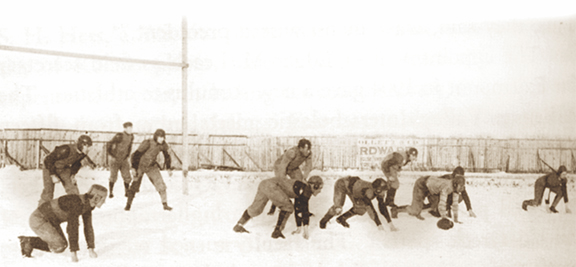
Few collegiate sport histories can match the highs and lows of Wichita State University’s football program. For 90 years, from 1896 through 1986, fall football games were rallying points for many in the Shocker community.
As one Parnassus writer penned back in 1921: “When Fairmount plays football, the game is not played by eleven men in moleskins. It is played by every student in the school. Co-eds, professors, students of every class and kind are on the side lines, and if you don’t believe that they take an active part in the game, just stand in front of the Fairmount rooters section some time — that is, if you don’t mind losing your ears.”
This spring, led by former Shocker offensive guard Jay Hull ’83, WSU football players are calling the shots for a return to campus to celebrate their common gridiron bond and pay respects to the unique history that is Shocker football.
Hosted by the WSU Alumni Association,* the player-organized reunion is slated for Fri.-Sat., May 15-16 and will feature a welcome barbecue, Shocker baseball vs. Creighton, a golf outing and a formal evening dinner and celebration.
Although far from complete, the Shocker football timeline is a kick-off to the upcoming festivities — and a thank you for the memories.
— Connie Kachel White
This WSU Alumni Association-sponsored football reunion is not affiliated with any individual, group or organization whose mission is to restart football at Wichita State University.
1895 — Fairmount College, the earliest predecessor of Wichita State, is founded. On the second day of school, a group of students meet under a tree to discuss forming a football team, although it will be a year later before a football game is set up.
1896 — T.H. Morrison is elected captain and coach of Fairmount’s team. “There never was at any one time eleven men out to practice,” reports the 1906 Parnassus. “It was found difficult to get a game with any other team but after prolonged negotiations a game was arranged to be played on the old Garfield (now Friends) campus with the High School of this city. When the day for the game came it seemed as though we were not going to have enough men to play but the following team was finally scraped together and marched onto the gridiron to do battle for the honor of the yellow and black: Tull, LE; Roseberry, LT; Hall, LG; Johnson, C; Dowd, RG; Day, RT; Newton, RE; Morrison, capt and QB; Richter, LH; Fred Isely, RH; Torrey, FB; Grimstead, sub. Of these at least three were not students.” Fairmount loses.
1899 — For the first time in Fairmount history, a “regular” schedule of five games is played, resulting in two ties, one loss and two wins.
1900 — A former University of Kansas player, S.H. Hess of Wichita, agrees to coach Fairmount’s team. Total budget for the year is $500, including the coach’s salary. The team wins five of its eight games.
1904 — Roy J. Kirk, a student and the football manager, comes up with the name “Wheatshockers” prior to a game against the Chilocco “Indians.”
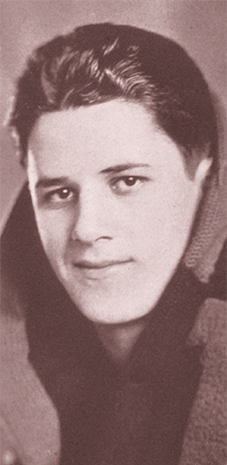
captains the
Wheatshockers
in 1925.
1905 — Coleman lanterns light the first Wheatshocker night game. “This year,” reports the 1906 Parnassus, “Fairmount tried the experiment of playing by night with artificial light, when Cooper was beaten 24-0. The experiment was a failure and promptly abandoned.”
1905 — On Christmas Day, Fairmount plays Washburn in the first game in the country played under new rules designed to temper the “brutality” of the sport. The rules permit the use of the forward pass. Neither team scores, but both claim credit for having thrown the first pass. The first toss by Fairmount is made by Bill Davis to Art Solter.
1909 — Although it was a hard year for the Wheatshockers (marked with an outbreak of typhoid fever that incapacitated many players as well as the coach later in the season), George Solter performs “a feat never recorded before in the annals of football at Fairmount — making a touchdown from kickoff, running the entire length of the field.”
1914 – Injuries and illness plague the players, so explains the 1915 Parnassus: “Robert Burgess, ‘17. Captain. R. Tackle. ‘Bob.’ The bright star of the line. His long suit was breaking up the opponents’ plays behind the line. His war cry, ‘Hook ‘em cow,’ was anything but music to his opponents’ ears. Injuries in the Baker Game kept Bob from being an all-state tackle. Weight, 170 lbs. Height, 6 ft. 1 in. Age, 21. Vernon Walling, ‘15. Tackle and Guard. ‘Vern.’ Smallpox kept him off all-state team. He was a tower of strength both on offensive and defensive work. Weight, 170 lbs. Height, 6 ft. Age, 27.”
1920 — Playing in the Kansas Conference, Fairmount beats Bethany, St. Mary’s, Sterling and Pittsburg, while being defeated by Friends, Washburn and Emporia and tying Wesleyan and Southwestern.
1925 — The Wheatshockers are the only Kansas Conference team to score in every game. Fairmount’s record is six wins, two losses and one tie.
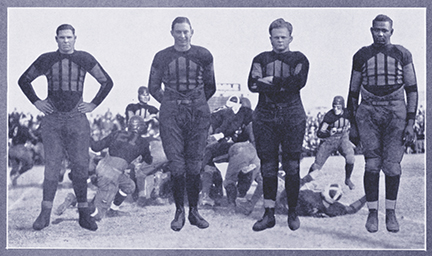
guard; Joe Stitt, left halfback; John Meyers,
center; and Lester Foust, right tackle.
1926 — Fairmount College becomes the Municipal University of Wichita. WU’s football team features a roster of diverse players, including Lester Foust.
1930 — Al Gebert, newly graduated from Notre Dame where he played for Knute Rockne, becomes head coach. He continues coaching the Shockers through 1941, compiling a record of 68-40-6, for the longest tenure and most victories by any Wichita State coach.
1931 — Gebert coaches WU to a 7-3 season and a tie for the Central Conference championship.
1932 — The Shockers become undisputed conference champs, and four players make the first All-Conference team: end Ray Beeman, tackle Red Shadoan, quarterback Louis Koch and halfback Charles McLaughlin.

five conference
championships from
1930 to 1941.
1933 — Assisted by former player Shadoan, who takes up line coach duties, Gebert leads WU to an 8-2 record and another conference title.
1937 — Led by future Shocker Hall of Famer Harold Brill, WU highlights a 7-3 season with an upset of Kansas, 18-7. Brill runs for a touchdown and passes for another as the Shockers score their only football win over KU until 1982.
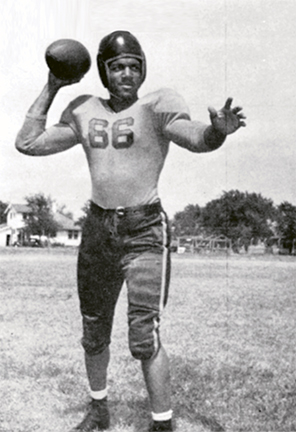
standout player for
Wichita University from
1944 to 1948, is a charter
member of the Pizza Hut
Shocker Sports Hall of
Fame.
1938 — The Shockers go undefeated in the Central Conference for the second year straight. They also make their debut into “big-time football” by playing their season opener against Army, one of the nation’s top teams. WU loses 32-0 at West Point.
1940 — Wichita University announces plans to build a 7,710-seat football stadium on the northeast part of the campus if, according to a Wichita Eagle article, “at least half of the estimated $100,000 cost can be obtained from the Work Projects Administration.”
1944 — Linwood Sexton joins the Shockers. During his four seasons with the team, he becomes WU’s career rushing leader with 1,995 yards and is recognized as an All-Missouri Valley halfback in 1945, 1946 and 1947. In 1979, he is inducted into the Pizza Hut Shocker Sports Hall of Fame.
1946 — The Shockers join the Missouri Valley Conference. The immediate post-World War II conference consists of Drake, Oklahoma State, St. Louis, Tulsa and Wichita State.
1946 – Named in tribute to the more than 17,000 World War II veterans from Sedgwick County, WU’s Veterans Field is in the final stages of construction, far enough along to usher in the football season with 8,000 permanent seats in place. When completed, the football stadium will have a bleacher-supported seating capacity of 16,000.
1946 — Anton “Hap” Houlik sprints 108 yards to score with an Arizona State kickoff to chalk up the country’s longest run of the year.
1947 — Sexton becomes a Missouri Valley sensation of the season with a 75-yard touchdown romp against St. Louis University at St. Louis. He is unanimously selected by his teammates as the 1947 Shocker honorary grid captain and the team’s most valuable player.
1947 — Jimmy Nutter averages 8.93 yards per carry his freshman season as a Shocker. He ranks 22nd in the nation in total rushing yards.
1948 — On Jan. 1, the Shockers play in the third annual Raisin Bowl in Fresno, Calif., where they lose to the College of the Pacific Tigers, 26-14. WU, which boasts the nation’s seventh best offense, goes to Fresno with a 7-3 record. The game is head coach Ralph Graham’s last at WU.
1948 — Valley champ Tulsa University and runner-up WSU collide on a soggy Veterans Field before 12,500, the second largest crowd to watch a college game in Wichita. The Shockers battle the Golden Hurricane to a 14-14 deadlock.
1948 — On Dec. 31, WU travels to Lafayette, La., to play Hardin-Simmons in the Camellia Bowl. The Shockers enter the post season with a record of 5-3-1 under first-year coach Jim Trimble, but they drop the contest, 49-12. The next day, they watch the Sugar Bowl classic in New Orleans.
1950 — Eddie Kriwiel sets 12 Shocker quarterbacking records during his WU playing career, 1947-50. In 1968, he returns to WSU to coach football.
1951 — The first night game at Veterans Field takes place Sept. 22, when a crowd of 12,500 watches Miami University of Ohio drop the Shockers 21-13. It is Bob Carlson’s first game as head coach of the Shockers.
1954 — WU compiles a 9-1 record and captures the MVC crown, its first MVC conference championship in any sport. Statistically, the season is the best in school history, bettering the 1908 record of 8-1 and the 8-2 record posted in 1933.
1955 — Wichita University shares the MVC gridiron title with the University of Detroit. The Shockers finish 7-2-1, including what is often considered one of their greatest victories, a 54-0 stomping of the Tulsa Hurricane on Thanksgiving Day.
1959 — The Shockers shut out Kansas State, 19-0, in the opening game of the season and go on to post a 5-4-1 record, their first winning season since 1955. At season’s end, Chalmer “Woody” Woodard resigns after three years as head coach, and three-year running back Ted Dean is drafted by the Philadelphia Eagles.
1960 — Bruising defensive play by center Roland Lakes, guard Charley Wright and end Nelson Toburen plus the kicking skill of tackle Bill Seigle nets the Shockers a 7-6 victory over Dayton on a muddy Veterans Field. Lakes is later drafted by the San Francisco 49ers.
1960 — For the second time in their history, the Shockers win the MVC title outright after defeating N. Texas State, 34-6. First-year WU head coach Hank Foldberg nabs MVC coach of the year honors.
1961 — Bill Parcells suits up as a Shocker linebacker. The three-year letterman earns a reputation as a hard-nosed player. He’s drafted in the seventh round by the Detroit Lions, but opts for a career in coaching.
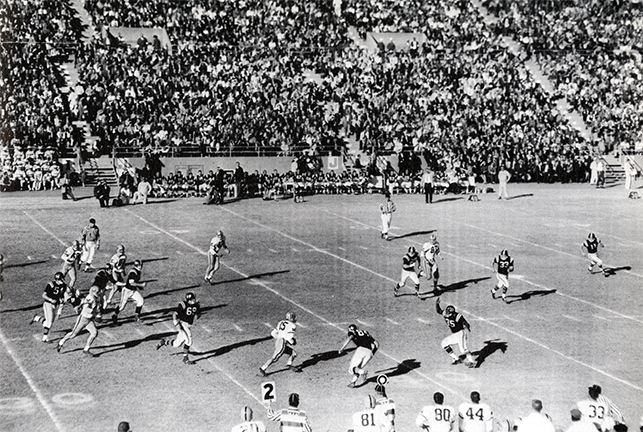
1961 Sun Bowl, losing by a score
of 17-9.
1961 — The Shockers again battle their way to an MVC championship and play in the Sun Bowl on Dec. 30. They lose to Villanova by a score of 17-9. The photo at left is from this gridiron contest. Among the players in the right half of the shot is Parcells in white wearing No. 87.
1962 — Despite trouncing New Mexico State 24-6 and Montana State 32-10 in non-conference play, WSU fails to defend its MVC crown and goes 4-6 on the season.
1962 — A familiar sight (and sound) at WU home games is BLACKJACK, the Pershing Rifles cannon that signals Shocker touchdowns.
1963 – Led by second-year head coach Marcelino “Chelo” Huerta, the Shockers go 7-2 and win their third MVC title in four years, but a game cancelled due to President Kennedy’s assassination probably costs them a bowl bid. Quarterback Hank Schichtle and receiver Bob Long rewrite the WSU record book for season passing and receiving statistics, as the Shockers finish the season ranked in the top 10 in the nation in seven statistical categories.
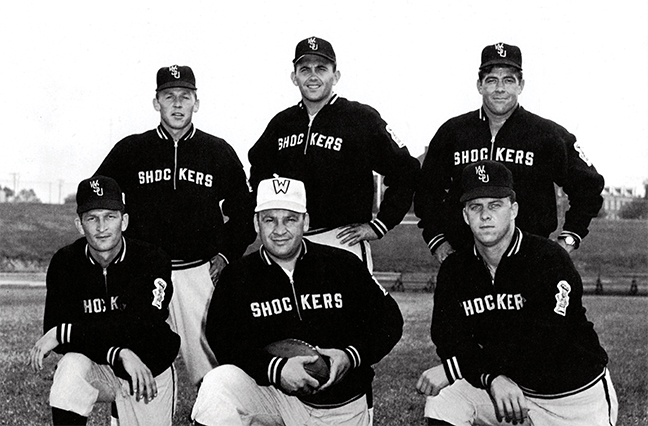
Bill Parcells, front row right, came to the
University of Wichita to play football in
1961. After graduating in 1964, he was
the seventh-round draft pick of the
Detroit Lions, but opted to accept an
assistant coaching position at Hasting
College in Nebraska. After a year, he
returned to his alma mater for a brief
coaching stint before ultimately setting
records as an NFL coach.
1964 – The Municipal University of Wichita becomes Wichita State University. The Shockers finish their first season as a state school with a 4-6 record and and place third in the Missouri Valley.
1965 — Parcells returns to Wichita State to coach the defensive line. He goes on to legendary coaching status in the National Football League, winning two Super Bowl rings with the New York Giants, in Super Bowl XXI and Super Bowl XXV.
1966 – The players’ helmets are updated to a bright shade of gold with a black-outlined oval containing a “W” on each side.
1968 — A proposal for the expansion of WSU’s football stadium to a 30,500-seat venue is announced. The stadium is to be renamed Cessna Stadium in recognition of a $300,000 pledge from Cessna Aircraft Co. Despite concerns about financing, the university’s faculty senate endorses the $1.5 million project, and Wichita State students voice their approval by a vote of 3,186 to 2,097.
1969 — On Sat., Sept. 13 a crowd of 28,200 comes out for the inauguration of Cessna Stadium. Wichita State beats Utah State 17 to 7.
1970 — A record-breaking home crowd of 30,055 on Sept. 20 saw the black-and-gold clad Shockers trounced 53-14 by Arkansas State.
1970 — On Oct. 2, one of two planes carrying players, staff and fans to a game in Logan, Utah, against Utah State crashes near Silver Plume, Colo., about 40 miles from Denver, killing 31 including head coach Ben Wilson. There are nine survivors on the plane, one of two flying to the game.
1970 — After a pause, head coach Bob Seaman, the remaining Shockers, freshman players and staff continue a “Second Season” with an Oct. 24 game against No. 9 Arkansas in Little Rock. The Razorbacks give Wichita State a standing ovation. After the game, the scoreboard reads 62-0. One Arkansas fan remarks, “I don’t care what the score was. They didn’t lose.”
1972 — The Shockers post a winning season of 6-5.

the University of
Tennessee Jim Wright
takes up head coaching
duties in 1974.
1974 — First-year head coach Jim Wright is determined to spread “Gold Fever,” along with a tough defense and an exciting passing offense — despite a dismal 1-9-1 season record.
1976 — Led by record-setting quarterback Sam Adkins’ 185 yards passing, the Shockers roll up 443 yards offensively on their way to a home victory, 21-0, against the Northern Illinois Huskies. This season-opening game at Cessna Stadium draws 27,311 fans.
1976 — The chances of the 3-7 Shockers beating 13th ranked Tulsa in the last game of the season seem slim to none. But behind the arm of Adkins, WSU upset the Hurricane 30-13 on regional television.
1977 — The team ends its season with a 5-6 record, its best in four years. Quarterback Jim Andrus sets a single game passing touchdown record with five against Indiana State in a 41-14 win. He also sets a new season touchdown pass mark with 15.
1977 — Although the final contest of the season is a 28-14 loss to Memphis State, a medley of post-game attractions helps alleviate the disappointment. The Shocker Sports Spectacular features a performance by the Dallas Cowboy Cheerleaders, a Taco Tico-Shocker $25,000 Money Pickin’ Scramble and a Cosmic Laser Beam-Fireworks Show.
1978 — Joe Williams ties an NCAA record that still stands, by kicking a 67-yard field goal in WSU’s 33-7 win over Southern Illinois.
1979 — WSU becomes the first NCAA Division 1-A school to hire a black head football coach, Willie “Jeff” Jeffries. In 2008, he is inducted into the National Black College Alumni Hall of Fame in Atlanta.
1982 — Jeffries unveils his prize defensive weapon, James “Jumpy” Geathers, who was red-shirted in 1981. Geathers’ pure physical force is felt first by his Shocker teammates. Offensive guard Jay Hull remembers practice clashes with him on the field. Hull says, “Games were almost easy compared to practice. I hated practice.”
1982 — Prince McJunkins, a senior quarterback who becomes the first player in NCAA history to rush for 2,000 and pass for 4,000 yards in a career, has his uniform number (No. 1) retired, joining Linwood Sexton as the only Shockers to be so honored.
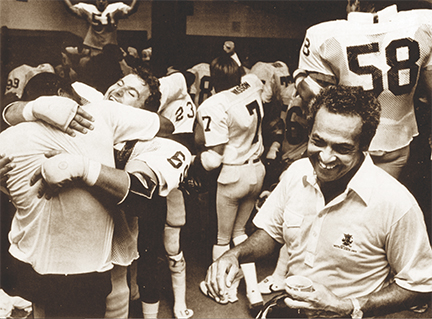
right, celebrates the "K-Who?" 13-10
victory over the University of Kansas
in 1982.
1982 — The Shockers trail KU 10-6 late in the fourth quarter. With two minutes remaining, a block by Mark O’Neal allows McJunkins to spot Don Dreher alone in the KU secondary. Dreher makes the catch and dives over the goal line for the 13-10 win.
“That win,” McJunkins says later, “was one of the greatest.” Geathers agrees, “To me, the KU game ranks up there like the Super Bowl.” The photo at left is the celebration in the locker room, with Coach Jeffries smiling at right.
1982 — The season is a record-setting one for the Shockers, whose rushing offense is ranked 10th nationally. Attendance hits a high point, averaging some 23,000 fans per game. And WSU’s 8-3 record is the school’s best since 1961.
1983 — WSU’s record flip flops to 3-8. KU takes revenge with a 57-6 massacre, and the closing home game of the season draws only 3,911 faithful to Cessna Stadium.
1983 — A four-year starter, Reuben Eckels completes his Shocker career as WSU’s all-time leader in reception yardage with 2,068. He ranks second in catches with 123, and also caught a school-record 11 touchdown passes.
1983 — Geathers records 11 sacks this season, his last with the Shockers, including four in a 10-tackle performance against Missouri Southern. He is drafted by the New Orleans Saints and goes on to a long pro career.
1984 — Sergio Lopez-Chavero sets an NCAA record by kicking three field goals of more than 50 yards in a single game, connecting from 54, 54 and 51 yards in a WSU win at Drake.
1986 — Wichita State’s last home game of the season draws 4,223 fans to Cessna Stadium. Its final game is an away 52-6 loss on Nov. 15 to Arizona State University.
1986 — Although the decision will prove controversial for decades, Shocker football is discontinued. Reasons cited include mounting debt, poor attendance, recruiting violations and the disrepair of Cessna Stadium.
Timeline compiled by David Dinell, Brendan Kachel, Molly Walsh, Connie Kachel White; contributors Mike Kennedy, George Platt. Sources: personal interviews, The Shcoker archives, WSU Alumni Association Memorabilia Collection, Parnassus, The Sunflower, WSU Libraries, Department of Special Collections.
Pizza Hut Shocker Sports Hall of Fame Football Members
Strong Hinman • Carnot Brennan • Cecil Jordan • Lindsay Austin • Paul Vermillion • Robert "Red" Shadoan • Al Gebert • Frances Johnson • Harold Brill • Pike Gawthrop • Lyle Sturdy • Linwood Sexton • Anton Nutter • Dick Sanders • Jim Klisanin • Ted Dean • Roland Lakes • Bob Long • Henry Schichtle • Bill Parcells • Jim Waskiewicz • Rick Dvorak • Sam Adkins • Prince McJunkins • Reuben Eckels • James "Jumpy" Geathers





